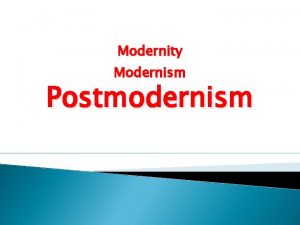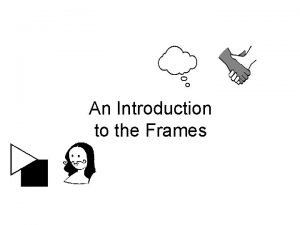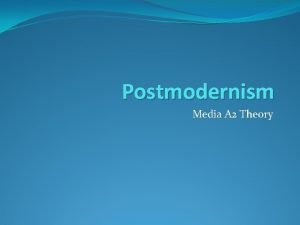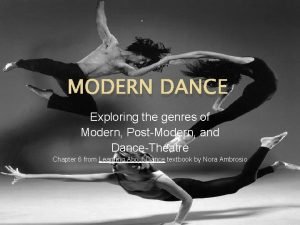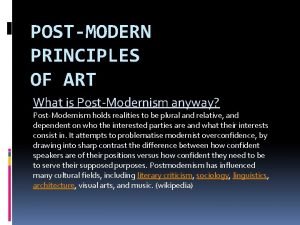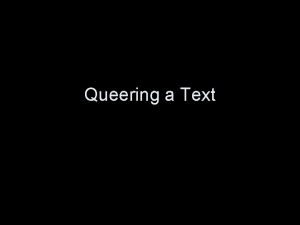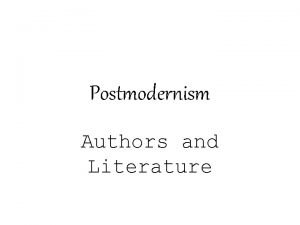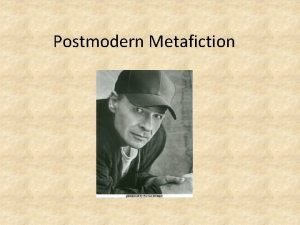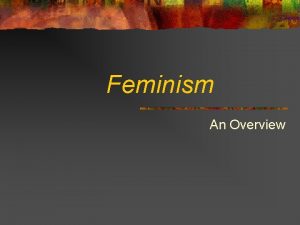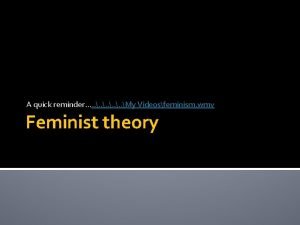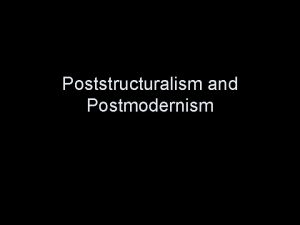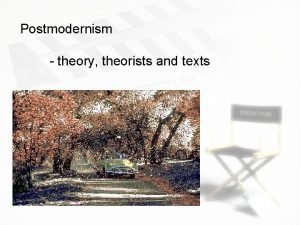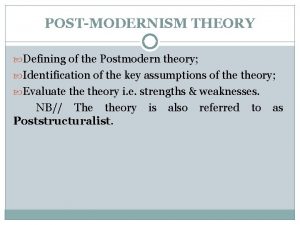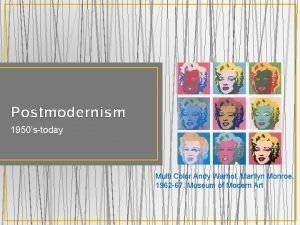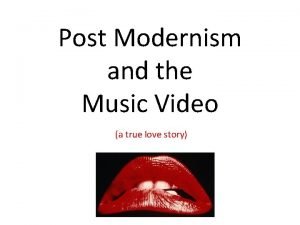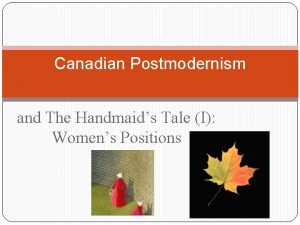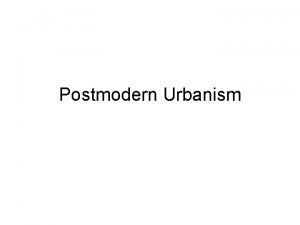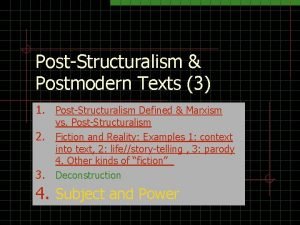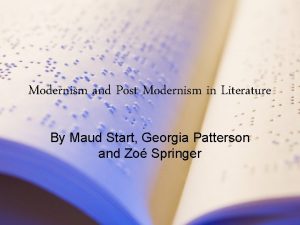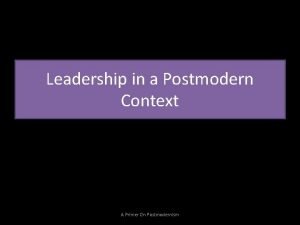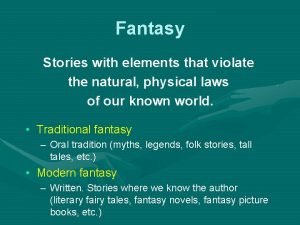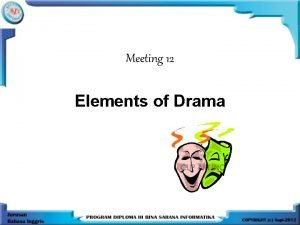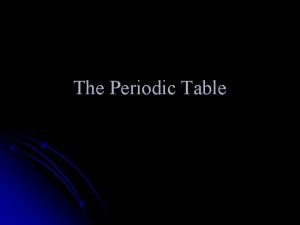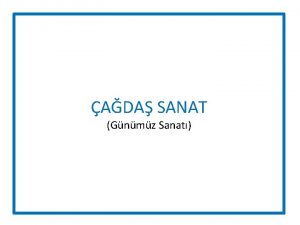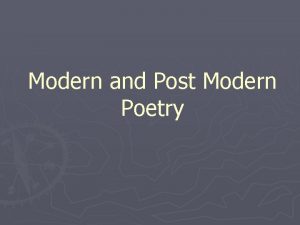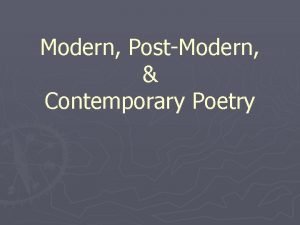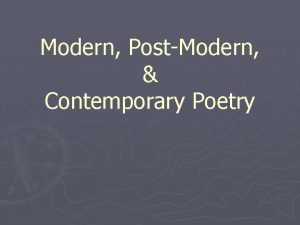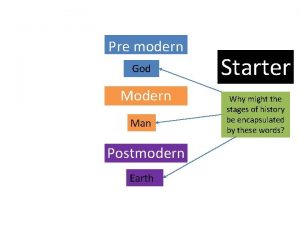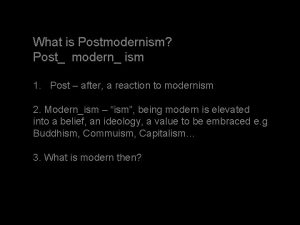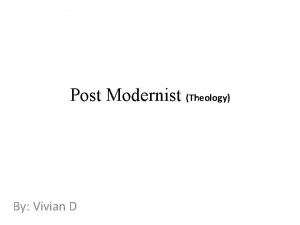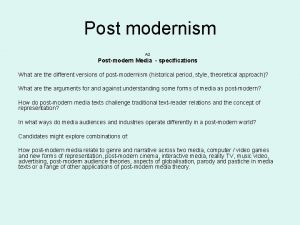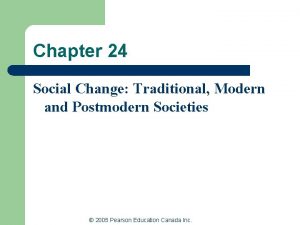PostModern Elements POST MODERN ELEMENTS PostModern Elements From








































- Slides: 40

Post-Modern Elements

POST MODERN ELEMENTS Post-Modern Elements From Postmodern Principles by Olivia Gude Appropriation Juxtaposition Recontextualization Layering Other ideas Interaction of Text & Image Imitationalism & Hybridity Literal Qualities Gazing Emotionalism & Representin’ Expressive Qualities Design Qualities Formalism

Postmodern Art MEDIA & PROCESSES Collage / montage Photography Video Film / animation Assemblage Performance art Installations Digital imaging & graphics Text & image amalgams Multimedia / virtual reality Traditional & historical media Interactive communication

CONCEPTUAL APPROACHES Postmodern Art Appropriation Parody Pastiche Narrative Abstraction Intervention Metaphor / irony Personal myth Serial imagery Ambiguity Pluralism Fragmentation Networks (non-linear)

Post-Modern Elements JUXTOPOSITION Artistic strategy which provides more than simple opportunities to present contrasting elements in a composition Careful & close positioning of compositional elements which can provide a wide range of meanings from humour to spiritual insight Juxtaposition involves placing two elements within an artwork for the purpose of comparing or contrasting them (creating new meaning). Elements can be compared by placing side by side, on top or below each other, or layering them in the foreground, background or middleground.

JUXTOPOSITION Andy Warhol, “Mick Jagger”

JUXTOPOSITION

JUXTOPOSITION http: //www. flickr. com/photos/evilnick/22995244/

JUXTOPOSITION Salvador Dali, “The Three Sphinx of Bikini”

Post-Modern Elements LAYERING As images become cheap and plentiful, they are no longer treated as precious, but instead are often literally piled on top of each other. Layered imagery evoking the complexity of the unconscious mind is a familiar strategy in Surrealist art and of early experimental approaches to photography. In postmodern works by artists such as David Salle, Sigmar Polke, and Adrian Piper, the strategy evokes the layered complexity of contemporary cultural life (Fox, 1987; Grosenick, 2001). Multiple layers of varying transparency will increasingly be a readily available strategy to students because it is a common feature of most digital imaging programs such as Adobe Photoshop (Freeman, 2001). From Postmodern Principles by Olivia Gude

SIGMAR POLKE b. 1941 UNTITLED, 1999

APPROPRIATION Post-Modern Elements To appropriate something involves taking possession of it. In the visual arts, the term appropriation often refers to the use of borrowed elements in the creation of new work. The borrowed elements may include images, forms or styles from art history or from popular culture, or materials and techniques from non-art contexts. Since the 1980 s the term has also referred more specifically to quoting the work of another artist to create a new work. The new work does not actually alter the original per se; the new work uses the original to create a new work. In most cases the original remains accessible as the original, without change. http: //en. wikipedia. org/wiki/Appropriation_(art)

APPROPRIATION Koons: I’m basically the idea person. I’m not physically involved in the production. I don’t have the necessary abilities, so I go to the top people, whether I’m working with my foundry — Tallix — or in physics. I’m always trying to maintain the integrity of the work. I recently worked with Nobel prize winner Richard P. Feynman. I also worked with Wasserman at Dupont and Green at MIT. I worked with many of the top physicists and chemists in the country. Jeff Koons 1985 New York City, October 1986 http: //www. jca-online. com/koons. html

APPROPRIATION These posters belong to a series depicting major-league basketball stars in advertisements for Nike athletic shoes, Jeff Koons decided to frame and exhibit them as part of his 1985 show Equilibrium in New York. EDIT: These posters are not by Jeff Koons, they were selected by him Jeff Koons 1985

APPROPRIATION "Nike conjures a dream, one that the superstars of the NBA embody for millions of people. The conceits of the posters define this dream in terms of oddly traditional roles and references: Moses Malone is Moses, parting a sea of basketballs… EDIT: These posters are not by Jeff Koons, they were selected by him Jeff Koons 1985

APPROPRIATION … a small group of players form The Dynasty in 34 th Street; and a larger, formally posed gathering sitting in suits and ties at a long table on a basketball court is dubbed The Board Room. Jeff Koons 1985 EDIT: These posters are not by Jeff Koons, they were selected by him

APPROPRIATION Koons’ choices foreground the way that these almost exclusively black athletes are cast not just as stars, but in roles whose claim to power and respect reflects a traditional social system that in fact denies power or respect to most African -Americans. " EDIT: These posters are not by Jeff Koons, they were selected by him Jeff Koons 1985

APPROPRIATION Koons: “Richard (Prince) and I have been friends for many years. His work is more involved in the appropriation aspect, the aspect of theft, while my work comes Untitled (cowboy) 1989 Ektacolor photograph from the history of the ready 50 x 70 inches made, which for me is position of optimism. Whether I’m casting my Jim Beam decanter or creating a painting from a liquor ad, I receive all the legal rights from everybody — a very optimistic situation. ” Untitled (Kool-Aid), 1982 -84 Ektacolor photograph 24 x 20 inches http: //www. richardprinceart. com/index. html

APPROPRIATION Title: Turquoise Marilyn 1962 Andy Warhol Famous American artist - Pop Artist

APPROPRIATION & JUXTOPOSITION Title: Four Marilyns Andy Warhol Famous American artist - Pop Artist

Jeff Koons APPROPRIATION Koons: It’s basically the medium that defines people’s perceptions of the world, of life itself, how to interact with others. The media defines reality. Just yesterday we met some friends. We were celebrating and I said to them: “Here’s to good friends!” It was like living in an ad. It was wonderful, a wonderful moment. We were right there living in the reality of our media. Koons: The Nike ads were my great deceivers. The show was about equilibrium, and the ads defined personal and social equilibrium. There is also the deception of people acting as if they have accomplished their goals and they haven’t: “Come on! Go for it! I have achieved equilibrium!” Equilibrium is unattainable, it can be sustained only for a moment. And here are these people in the role of saying, “Come on! I’ve done it! I’m a star! I’m Moses!” It’s about artists using art for social mobility. Moses [Malone] is a symbol of the middle-class artist of our time who does the same act of deception, a front man: “I’ve done it! I’m

PARODY CONCEPTUAL APPROACHES • A parody (also called send-up or spoof), in contemporary usage, is a work created to mock, comment on, or poke fun at an original work, its subject, or author, or some other target, by means of humorous, satiric or ironic imitation. As the literary theorist Linda Hutcheon (2000: 7) puts it, "parody … is imitation with a critical difference, not always at the expense of the parodied text. " Parody may be found in art or culture, including literature, music … Wii Fit Parody http: //www. youtube. com/watch? v=_i. YBm. AVu. Bns

PARODY CONCEPTUAL APPROACHES Gerald Scarfe, Diana, Beckham & Blair

Post-Modern Elements FORMALISM In art theory formalism is the concept that a work's artistic value is entirely determined by its form--the way it is made, its purely visual aspects and its medium. Formalism emphasizes compositional elements such as colour, line, shape and texture rather than realism, context, and content. In visual art, formalism is the concept that everything necessary in a work of art is contained within it. The context for the work, including the reason for its creation, the historical background, and the life of the artist, is considered to be of secondary importance. Formalism dominated modern art from the late 1800 s through the 1960 s. Text from http: //en. wikipedia. org/wiki/Formalism_%28 art%29 viewed 6 Jan 2008

• • • Jackson Pollock was an American Abstract painter Founder of the Abstract Expressionist movement. He began painting with his canvases laid out on the studio floor. He used hardened brushes, sticks and even basting syringes as paint applicators. Pollock’s technique of pouring and dripping paint is thought to be one of the origins of the term ‘action painting’. With this technique Pollock was able to achieve a more immediate means of creating art, the paint now literally flying from his chosen utensil onto the canvas. By defying the conventional way of painting on an upright surface, he added a new dimension, literally, by being able to view and apply paint to his canvases from all directions. Jackson Pollock No. 5 (1948)

Helen Frankenthaler’s Paintings Mountains and Sea 1952 Oil on canvas 7' 2 5/8" x 9' 9 1/4" Magic Carpet, 1964 96 X 68 inches Acrylic on Canvas

NARRATIVE CONCEPTUAL APPROACHES • Stories are an important aspect of culture. Many works of art, and most works of literature, tell stories; indeed, most of the humanities involve stories. • Stories are of ancient origin, existing in ancient Egyptian, ancient Greek, Chinese and Indian culture. Stories are also a ubiquitous component of human communication, used as parables and examples to illustrate points. Storytelling was probably one of the earliest forms of entertainment. Narrative may also refer to psychological processes in self-identity, memory and meaning-making. http: //en. wikipedia. org/wiki/Narrative

NARRATIVE CONCEPTUAL APPROACHES Norman Rockwell (American, 1894 -1978), The Problem We All Live With, published in Look, January 14, 1964, oil on canvas, Arts International, Chicago. http: //www. artlex. com/Art. Lex/n/narrative. html

NARRATIVE CONCEPTUAL APPROACHES I dreamed I was having my photograph taken with a group of people. Suddenly, I began to rise up and fly around the room. Half way around I tried to get out the door. When I couldn't get out, I continued to fly around the room until I landed and sat down next to my mother who said I had done a good job! Jonathan Borofsky 1983 http: //www. nga. gov/education/american/narrative. shtm

RECONTEXTUALIZATION to place (as a literary or artistic work) in a different context

RECONTEXTUALIZATION BLOG POST: Wednesday, December 12, 2007 the police found a fake bomb at the Royal Ontario Museum, courtesy of colossal idiot/art student Thorarinn Ingi Jonsson. His "art" project consisted of the fake bomb itself and a You. Tube video showing a fake bombing of the museum. Jonsson defended his worthless project by calling it "recontextualization, " one of the half-baked art theories created to allow The premise of recontextualization is that placing an item in a different context changes its meaning. Or, to worthless empty-heads to flourish in the art world. put it another way, it's a sophisticated-sounding pretense for really lazy people with no abilities, since it allows you to take any object, place it in an unusual context and say that it's art. http: //steveriffic. blogspot. com/2007/12/recontextualizing-idiot-yet-another-art. html



“Whether Mr. Mutt made the fountain with his own hands or not has no importance. He CHOSE it. He took an article of life, placed it so that its useful significance disappeared under the new title and point of view – created a new thought for that object. ”

Physical craft Intellectual interpretation Conceptually driven vs. Aesthetically driven

HYBRIDITY In art forms, hybridity could mean the blurring of traditional distinct boundaries between artistic media such as painting, sculpture, film, performance, architecture, and dance. It also can mean cross-breeding art-making with other disciplines, such as natural and physical science, industry, technology, literature, popular culture, or philosophy. Hybrid art forms expand the possibilities for experimentation and innovation in contemporary art. Title: Prototype for New Understanding #8, 1999 Materials: Nike athletic footwear, human hair http: //schools. walkerart. org/arttoday/index. wac? id=2355

Today’s artists are free to make art with whatever material or technique they can imagine. This freedom creates new opportunities to express ideas and concepts. It also opens up a number of challenges, choices, and decisions for artists: HYBRIDITY Should I work to master a traditional art form or should I work to create innovative new art forms? Or should I do both? Should I experiment with materials that are industrial or outside the scope of my studio if those materials seem to be the best way to express my artistic goals? http: //schools. walkerart. org/arttoday/index. wac? id=2355

HYBRIDITY How can I define myself as an artist if I am shifting, combining, and recombining techniques from inside and outside the worlds of art? Blurring boundaries, breaking rules, and creating hybrids occupies much artistic work today. However, making meaning in art—whatever tools, materials, or techniques are used— remains central to artistic practice. It is important for viewers to keep this in mind as they explore innovative art today. http: //schools. walkerart. org/arttoday/index. wac? id=2355

PASTICHE An artistic work in a style that imitates that of another work, artist, or period. Unlike parody, pastiche celebrates, rather than mocks, the work it imitates. http: //www. ponderabout. com/archives/1941/pastiche

PASTICHE An imitation of a narrative or film genre. Si http: //www. ponderabout. com/archives/1941/pastiche
 Premodern modern postmodern timeline
Premodern modern postmodern timeline Perbedaan konseling modern dan postmodern
Perbedaan konseling modern dan postmodern Post modern frame
Post modern frame Post modern therapy
Post modern therapy Postmodern art principles
Postmodern art principles What is postmodern frame
What is postmodern frame Postmodernism media
Postmodernism media Postmodern art principles
Postmodern art principles Post modern dance
Post modern dance Postmodern principles
Postmodern principles Post modern
Post modern Foucault friendship as a way of life
Foucault friendship as a way of life Literary movements in british literature
Literary movements in british literature Postmodernist authors
Postmodernist authors Metafiction in postmodern literature
Metafiction in postmodern literature Eclectic postmodern
Eclectic postmodern Slumy bilbao
Slumy bilbao Christians values
Christians values Postmodern feminism
Postmodern feminism Postmodern feminism
Postmodern feminism Postmodern feminism
Postmodern feminism Postmodern tarih anlayışı
Postmodern tarih anlayışı Postmodern milieu
Postmodern milieu Post modernism theory
Post modernism theory Post modernism sociology
Post modernism sociology Postmodernism andy warhol
Postmodernism andy warhol Postmodern mimari özellikleri
Postmodern mimari özellikleri Backstreet boys video
Backstreet boys video Postmodern architecture homes
Postmodern architecture homes Postmodernism in handmaid's tale
Postmodernism in handmaid's tale Postmodern urbanism
Postmodern urbanism Toronto weather
Toronto weather Postmodern authors
Postmodern authors The biopolitics of postmodern bodies
The biopolitics of postmodern bodies Postmodern
Postmodern Characteristics of postmodernism
Characteristics of postmodernism Postmodern leadership style
Postmodern leadership style Elements in traditional fantasy
Elements in traditional fantasy Elements of modern computer
Elements of modern computer 10 elements of drama
10 elements of drama Father of modern periodic table
Father of modern periodic table
